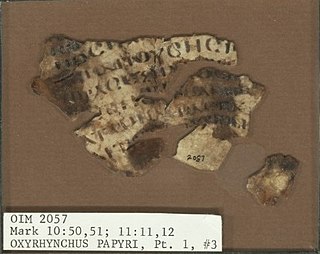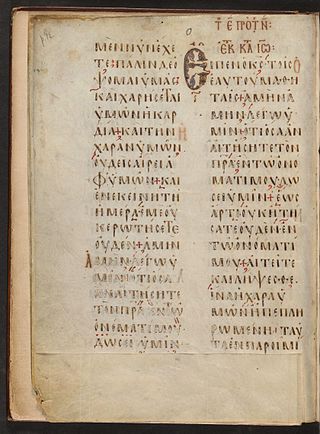| New Testament manuscript | |
| Name | Codex Athous Panteleimon |
|---|---|
| Text | Revelation of John |
| Date | 10th century |
| Script | Greek |
| Now at | Monastery of St Panteleimon |
| Size | 29.5 x 23 cm |
| Type | Byzantine text-type |
| Category | V |
Codex Athous Panteleimon, designated by 052 (in the Gregory-Aland numbering), and known as Uncial 052, is a Greek uncial manuscript of the New Testament. It is dated paleographically to the 10th century.
The codex contains incomplete text of Revelation of John (7:16-8:12), with a commentary of Andreas's (see Uncial 051), on 4 parchment leaves (29.5 by 23 cm). The text was written in two columns per page, 27 lines per page. [1]
The text is divided according to the κεφαλαια (chapters), whose numbers are given at the margins, and the τιτλοι (titles of chapters) at the top of the pages. There is also another division according to the λογοι. [2]
The Greek text of this codex is a representative of the Byzantine text-type. Aland placed it in Category V. [1] The text was collated and edited by Herman C. Hoskier.
Currently it is dated by the INTF to the 10th century. [3]
The codex is located on Mount Athos in the library of the Monastery of St Panteleimon (99,2). [1] [3]

Codex Macedoniensis or Macedonianus designated by Y or 034, ε 073, is a Greek uncial manuscript of the Gospels, dated palaeographically to the 9th century. The manuscript is lacunose.
Uncial 051, is a Greek uncial manuscript of the Book of Revelation, dated paleographically to the 10th century.
Uncial 063, ε 64 (Soden), is a Greek uncial manuscript of the New Testament, dated paleographically to the 9th century.

Uncial 069, ε 12 (Soden), is a Greek uncial manuscript of the New Testament, dated paleographically to the 5th century.
Uncial 075, Οπ3 (Soden), is a Greek uncial manuscript of the New Testament, dated palaeographically to the 10th century. Formerly it was designated by ג. It was also classified as minuscule codex 382p.
Uncial 091 in the Gregory-Aland numbering), ε 30 (Soden), is a Greek uncial manuscript of the New Testament, dated paleographically to the 6th-century.
Uncial 094, ε 016 (Soden); is a Greek uncial manuscript of the New Testament, dated paleographically to the 6th-century.
Uncial 099, ε 47 (Soden); is a Greek uncial manuscript of the New Testament, assigned paleographically to the 7th-century.

Uncial 0105, ε 45 (Soden), is a Greek uncial manuscript of the New Testament. It is dated paleographically to the 10th-century. Formerly it was labelled by Wn.
Uncial 0109, ε 52 (Soden), is a Greek uncial manuscript of the New Testament, dated paleographically to the 7th-century.
Uncial 0111, is a Greek uncial manuscript of the New Testament, dated paleographically to the 7th-century.
Uncial 0120, α 1005 (Soden), is a Greek uncial manuscript of the New Testament, dated palaeographically to the 9th-century. Vaya lokosñ
Uncial 0164, ε 022 (Soden), is a Greek-Coptic bilingual uncial manuscript of the New Testament, dated paleographically to the 6th century.
Uncial 0165, is a Greek uncial manuscript of the New Testament, dated paleographically to the 5th century.
Minuscule 180, ε 1498, α 300 (Soden), is a Greek minuscule manuscript of the New Testament, on parchment. The Gospels palaeographically have been assigned to the 12th century, the rest of New Testament books are dated by colophon to the 1273. Formerly it was deciphered as the year 1284. It has complex contents with full marginalia.
Minuscule 582, δ 410, is a Greek minuscule manuscript of the Greek Bible of the Old Testament and New Testament, on paper. Dated by a colophon to the year 1334. The manuscript has complex contents. It was labelled by Scrivener as 451.
Minuscule 627, α 53, is a Greek minuscule manuscript of the New Testament, on parchment. Palaeographically it has been assigned to the 10th century. The manuscript is lacunose. Tischendorf labelled it by 160a, 193p, and 24r. It has unusual order of books: the Book of Revelation is placed between Book of Acts and the Catholic epistles.
Minuscule 743, α1401 Aν414Nι40, is a Greek minuscule manuscript of the New Testament written on paper. Palaeographically it has been assigned to the 14th century. The manuscript has no complex contents. Scrivener labelled it as 738e.

Lectionary 296 (Gregory-Aland), designated by siglum ℓ296 is a Greek manuscript of the New Testament, on parchment. Palaeographically it has been assigned to the 10th century. The manuscript is very lacunose.

Minuscule 922, δ 200, is a 12th-century Greek minuscule manuscript of the New Testament on parchment. It has marginalia. The manuscript has survived in complete condition.